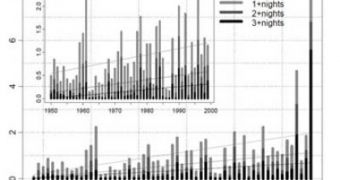For California, heat waves are nothing new. The state is constantly bathed by the sun, and benefits from an arid and hot climate. But, from time to time, massive heat waves come over it, such as the one in 2006, which killed 600 people, 5,000 cattle and 70,000 poultry in one swift blow. This all happened between mid July to early August, after which time temperatures returned to their normal levels. In a new study conducted by experts at the University of California in San Diego (UCSD) Scripps Institution of Oceanography, it is shown that their frequency is increasing constantly, and that more and more people are at risk each year.
The investigators looked at records spanning almost two decades, from the early 1990s to 2006. They determined that, other than the usual warm and dry day/cool night pattern, another one seemed to make itself more and more common. The second pattern is characterized by immense heat, with days also being extremely humid. The nights are not cool and dry, as people are accustomed to, but rather become hot and wet themselves.
“Water vapor is the main greenhouse gas. During the night in humid environments, air doesn't cool nearly as much as it does in dry conditions. Elevated humidity also causes heat waves to last longer. Hotter nights pre-condition hotter days and the cycle feeds on itself until the winds change. The weather pattern that traditionally causes heat waves in California is tending to bring with it more humidity, changing the character of heat waves from the dry daytime heat and cool nights typical for this region, to the muggy heat around the clock that locals are simply not accustomed to,” Alexander Gershunov, a Scripps climate scientist, explains the phenomenon.
Over the last six decades, the situation has become increasingly worrying. But it was never as bleak as it is now. In the current decade alone, three nighttime heat waves struck California – in 2001, 2003 and 2006 – each of them with unprecedented violence and consequences. People and livestock were caught unprepared, and simply could not cope with the sudden changes. The devastation on ecosystems, wildlife, electric grids, and water/electricity infrastructures was widespread, and a state of chaos was just barely avoided.
An area of the eastern Pacific Ocean was identified as being the source of humidity for the deadly heat waves. Oceanologists and meteorologists say that this specific area of the ocean has been under direct influence from human activity and man-made global warming, which heats the surface of the water so hard, that the water evaporates and moves inland.

 14 DAY TRIAL //
14 DAY TRIAL //